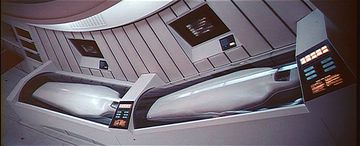Un manned space plane lands on its own after 2 years
Discussion
Cool but what's the purpose? Cargo bay is small.
Spy satelite that can change orbit quickly ? Come back refuel and go up again?
http://www.cbsnews.com/news/military-space-plane-l...
Spy satelite that can change orbit quickly ? Come back refuel and go up again?
http://www.cbsnews.com/news/military-space-plane-l...
Eric Mc said:
The X-37 is a test spacecraft. It is developing techniques and technology that may be used in a larger vehicle.
As you can see, the Shuttle concept is not dead - it's just in the hands of the military now.
I wonder if it has the same crossrange capability they demanded from the Shuttle, which necessitated its large wings - NASA's original designs had much smaller ( and lighter ) wings.As you can see, the Shuttle concept is not dead - it's just in the hands of the military now.
In proportion to the size of the vehicle, the X-37's wings seem to be close to those of the Shuttle. If that is the case, the cross range might be broadly similar.
I am sure the USAF would still love a spacecraft that they could launch from Vandenberg Air Force base on a polar orbit and have it land 90 minutes later back at Vandenberg - which was what the cross range specification was all about.
I am sure the USAF would still love a spacecraft that they could launch from Vandenberg Air Force base on a polar orbit and have it land 90 minutes later back at Vandenberg - which was what the cross range specification was all about.
It's worth considering what sort of "test" takes 2 years?
I.E. we are not talking about quick systems capability tests, but long term durability in a orbiting environment. Precisely the sort of tests the US military would love to do on the ISS, but which they are, wisely, prohibited from doing!
I can imagine a huge range of systems that would benefit from a long exposure test, from communications to surveillance etc. Having a relatively cheap and "recoverable" test bed capability must make the R&D and production of long term non recoverable orbiting space assets enormously easier.
I.E. we are not talking about quick systems capability tests, but long term durability in a orbiting environment. Precisely the sort of tests the US military would love to do on the ISS, but which they are, wisely, prohibited from doing!
I can imagine a huge range of systems that would benefit from a long exposure test, from communications to surveillance etc. Having a relatively cheap and "recoverable" test bed capability must make the R&D and production of long term non recoverable orbiting space assets enormously easier.
Eric Mc said:
No one knows for sure - but only one has been in space at any one time.
It was the second flight for this X-37B. The same plane circled the planet for more than seven months in 2010. A second X-37B spacecraft blasted off in March 2011 and spent more than a year in orbit.ash73 said:
Deeply impressive bit of kit, but the payload capacity is very limited. I wish they'd put as much effort (and money) into getting a manned flight to Mars.
Who's "they"?The US Department of Defense (which is funding the X-37) does not have, at the moment anyway, much call for manned Mars missions.
Gassing Station | Science! | Top of Page | What's New | My Stuff





